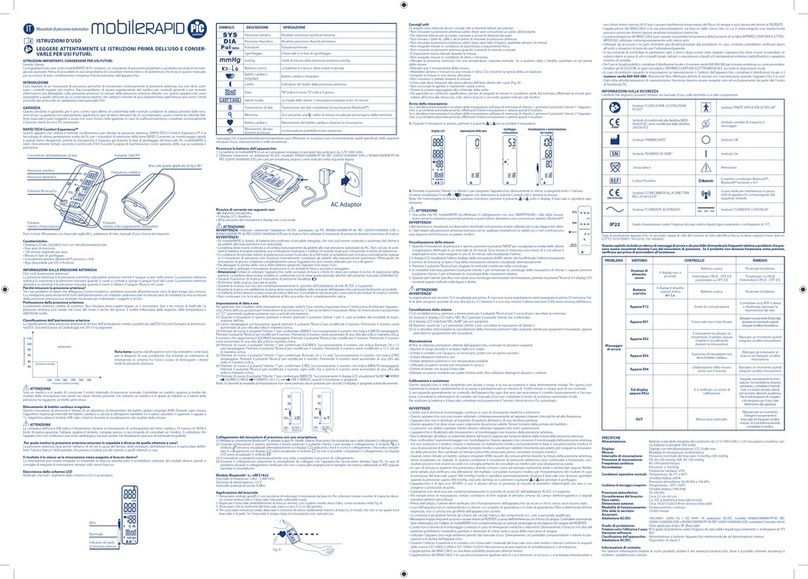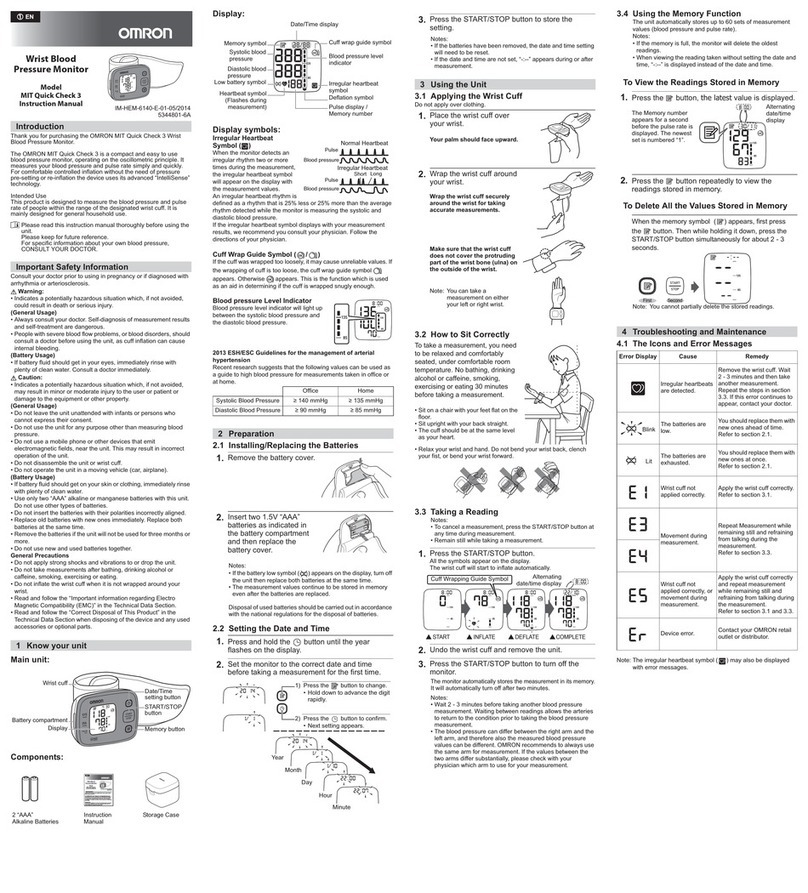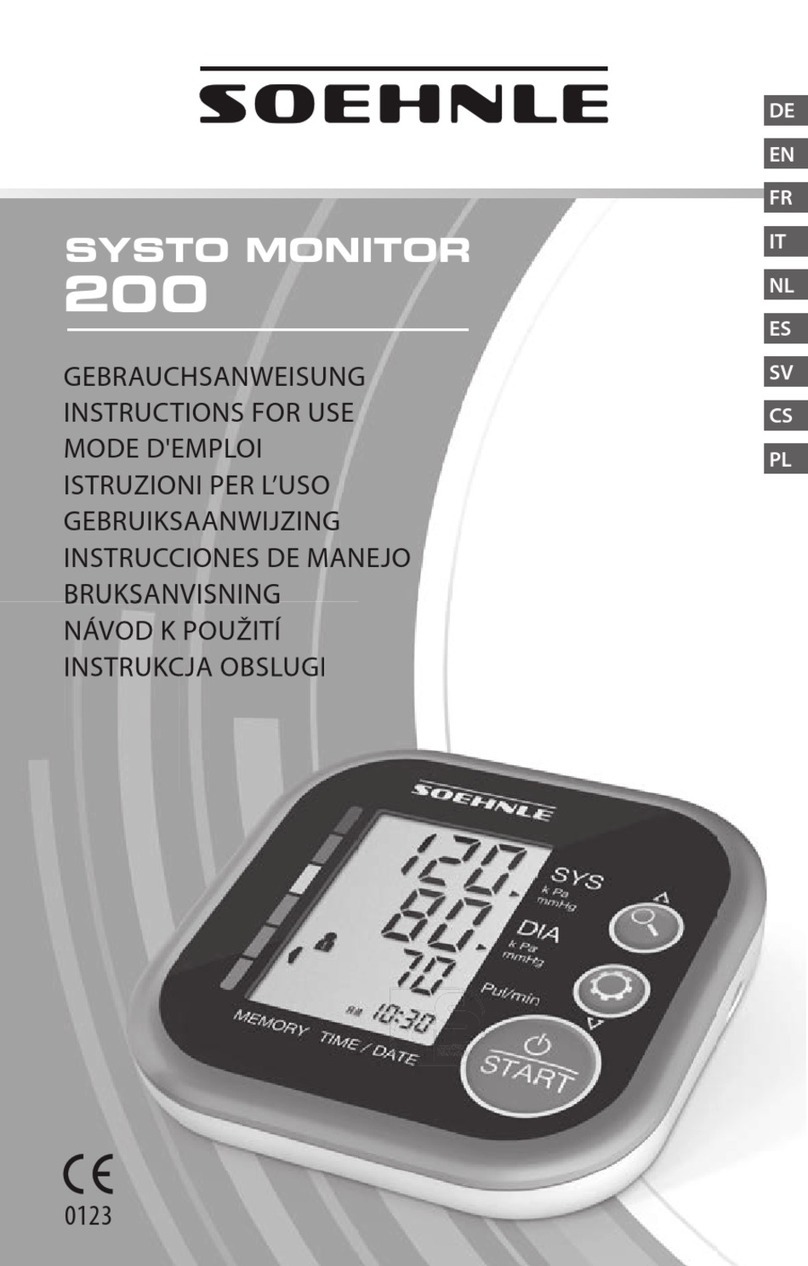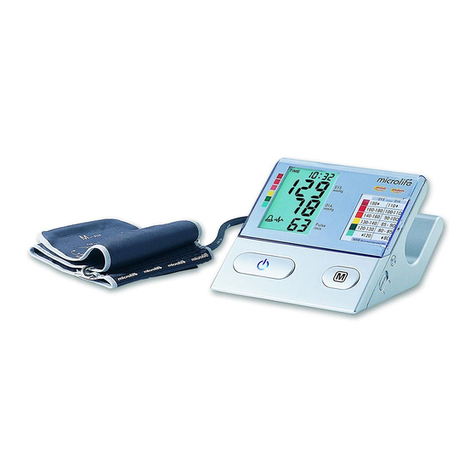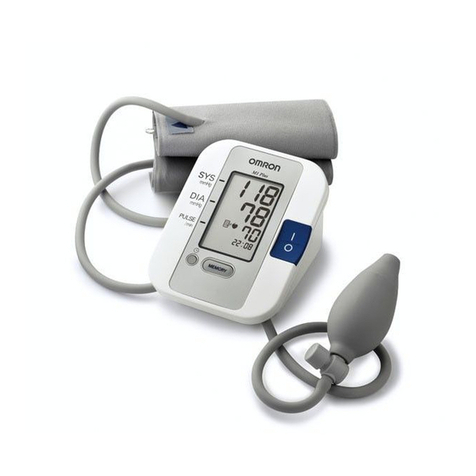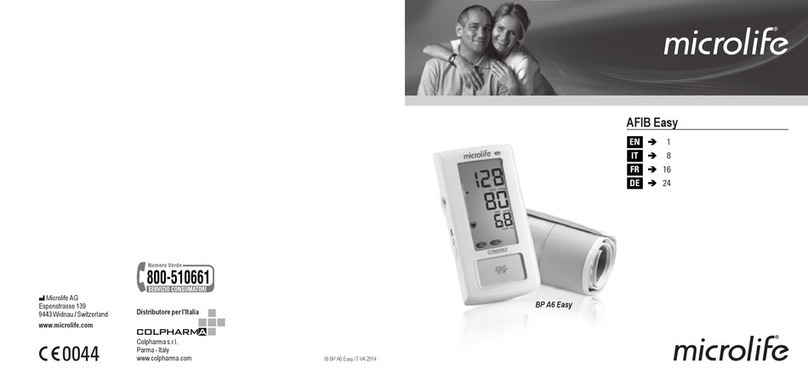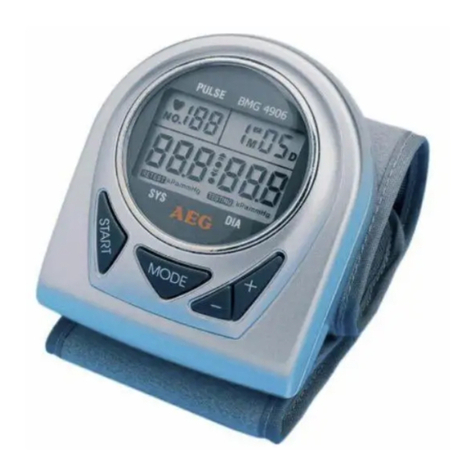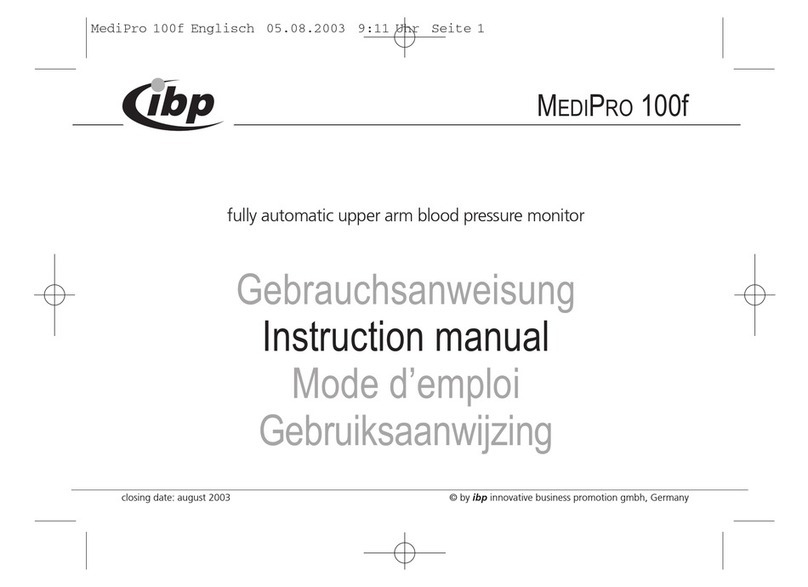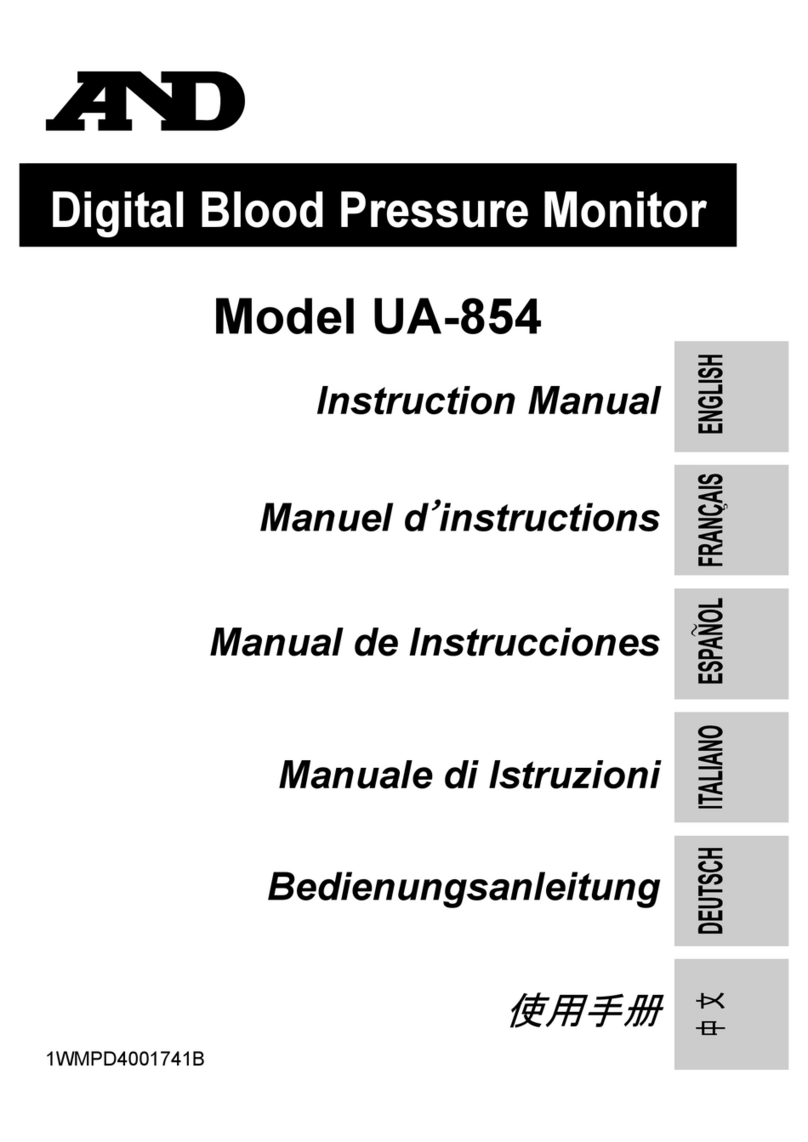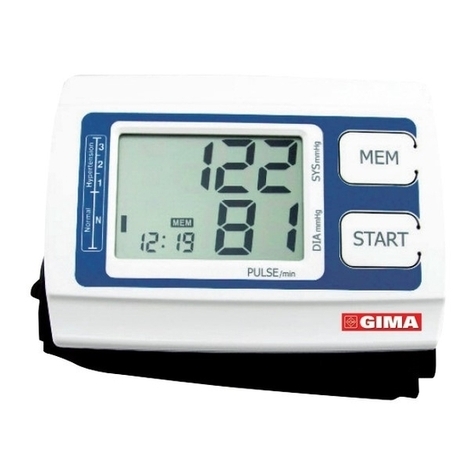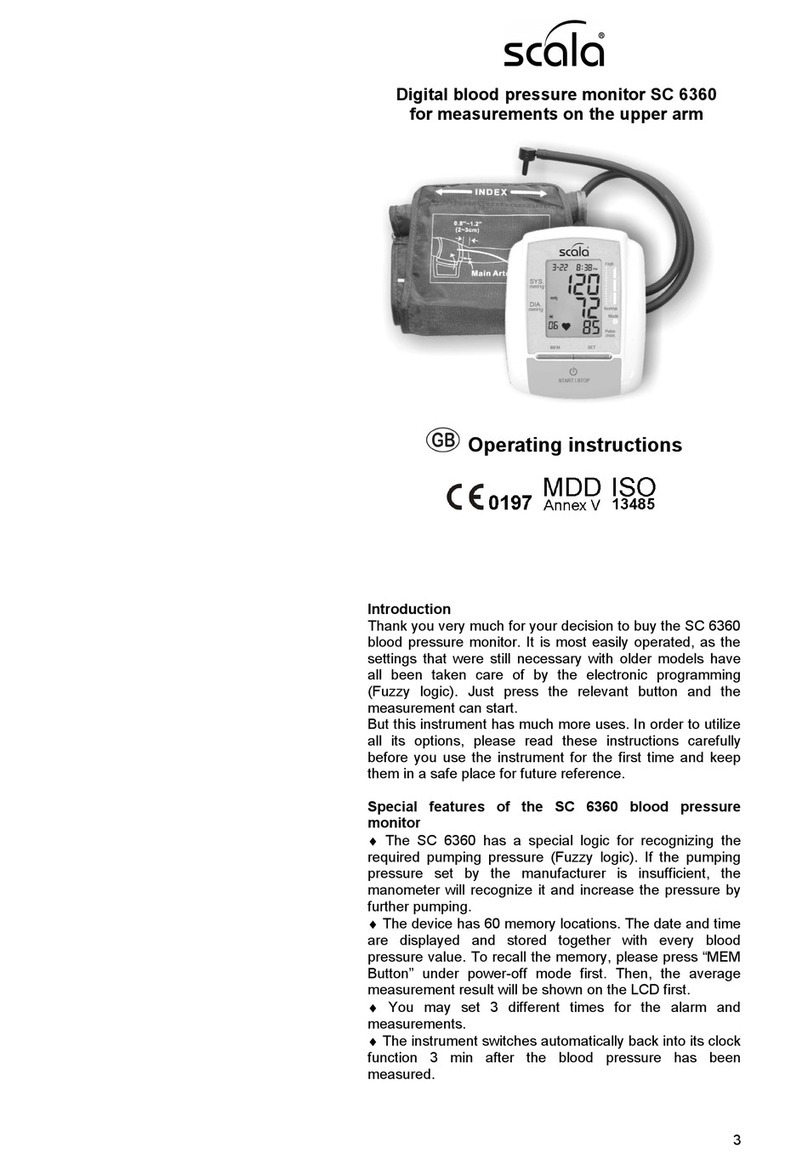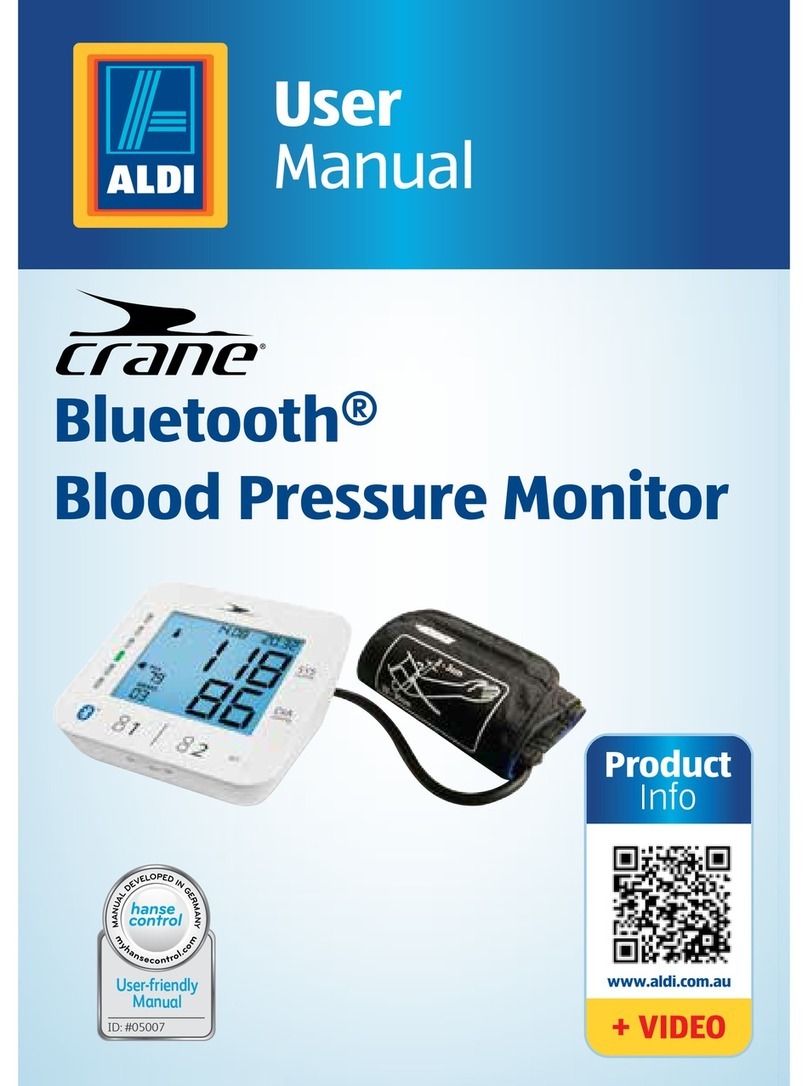RiteAid deluxe automatic User manual

RITE
w
health
care
blood
pressure
cuff
monitor
“
INSTRUCTION
MANUAL
{QT
model
#BP3AR1-4DRIEE


Important
Product
and
Safety
Information
Follow
Instructions
for
Use.
This
document
provides
important
product
@
operation
and
safety
information
regarding
this
Blood
Pressure
Monitor.
Please
read
this
document
thoroughly
before
using
the
device
and
keep
for
future
reference.
.
This
blood
pressure
monitor
is
an
automatic
digital
blood
pressure
measuring
device
;.
for
use
by
adults
on
the
upper
arm
at
home
or
in
the
doctor's
office.
It
enables
a
very
fast
and
reliable
measurement
of
the
systolic
and
diastolic
blood
pressure,
as
well
as
the
pulse
rate,
by
way
of
the
oscillometric
method.
This
device
detects
the
appearance
of
irregular
heartbeats
during
measurement
and
provides
a
warning
signal
when
the
'
irregular
heartbeat
is
detected.
The
device
can
be
used
in
connection
with
your
personal
computer
(PC)
running
the
Microlife'Blood
Pressure
Analyzer
(BPA)
software;
the
memo:
ry
data
can
be
transferred
to
the
PC
by
connecting
the
monitor
via
cable
with
theaPC'.
This
blood
pressure
monitor
IS
intended
to
be
used.
0
For
self-measurement/monitoring
of
blood
pressure
and
pulse
in
adults;
whereas
the
person
being
measUred
may
be
the
user/operator
of
the
device
0
Within
a
home
healthcare
environment.
7
-
,_
0
With
a
cuff
located
upon
the
user's
upper
arm;
36
inch
above
the
elbow
over
the
-
artery
as
indicated
on
the
cuff.
This
blood
pressure
monitor
IS
NOT
intended
for
use
with:
0
Pregnancy
0
Preeclampsia
..
0
Children
under
12
H
0
Neonatal
patients
WARNING—
Potentially
hazardous
situation
that
if
not
avoided
may
result
In
serious
injury
or
death.
0
Self-measuring
means
monitoring
not
dIagnosisor
treatment
Unusual
values'must
always
be
discussed
with
yourdoctor.
Under
no
circumstances
should
you
independ-
ently
alter
the
dosages
of
any
drugs
prescribed
by
your
physician.
“Consult
your
physician
bere
using
this
device
if
any
of
the
following
or
similar
con-
ditions
are
present:
arrhythmias
such
as
atrial
or
ventricular
premature
beats
or
atria
al
fibrillation,
arterial
sclerosis
poor
perfusion
diabetes,
age,
pregnancy,-
preeclamp—
sia,
renal
diseases
Motion
during
measurement
including
trembling
or
shivering
may
affect
the
measurement
.
.
as
1

‘0
Though
not
for
use
with
children
under
12-,
ensure
that
any
children
around
this
5’
device
are
supervised;
some
parts
are
small
enough
to
be
swallowed
and
any
pres-
ent
tubes
or
cables
may
provide
a
risk
of
strangulation.
..
.._
Ensure
the
cuff
tubing
Is
not
kinked
during
use
as
harmful
Injury
may
occur
due
to
the
effect
of
blood
flow
interference
caused
by
high
pressure.
in
the
cuff
not
releasing.
DO
NOT:
x
Use
this
device
if
you
think
it
is
damaged
or
anything
appears
Unusual
(e.
g
sporadic
operation,
open
packaging
upOn
purchase).
XUse
the
displayed
pulse
for
checking
the
frequency
of
heart
pacemakers
as
this
,1
'
device
Is
not
suitable
for
this
action.
'
x
open/modify
this
device;
inaccuracy
and/or
harmful
Injury
may
result.
X
Conduct
many
frequent
measurements
as
this
may
result
In
harmful
Injury
due
to
blood
flow
interference.
XIPlace
the
Cuff
over
a
wound
as
this
may‘cause
additona‘l
injury;
"
',
xPlace
and
pressurize
the
Cuff
over/near
any
present
intravascular
access
or
therapy,
or
arteriovenous
shunt,
as
this
may
cause
blood
flaw
interference
and
result
in
harmful
Injury.
'
X
Place
and
pressurize
the
Cuff
over
a
limb
near
the
side
of
a
mastectomy
as
this
may
cause
harmful
Injury
x
Use
the
Blood
Pressure
Monitor
on
a
limb
simultaneously
with
other
medical
equip-
ment
on
the
same
limb
due
to
possible
interference
with
such
medical
equipment.
X
Maintain
pressure
in
the
Cuff
applied
to
the
limb
for
a
prolonged
amount
of
time.
Ensure
that
circulation
in
the
limb
is
not
impaired
by
checking
circulation
if
pro~
longed/repeated
exposure
to
pressure
occurs.
X
Service
the
device
when.
being
used
or
when
power
is
supplied.
When
the
device
is.
not
in
use
and
power
is
removed,
cuff
assembly,
batteries
and
AC
adapter
(if
appli-
‘
cable)
may
be
replaced
by
the
user
with
Microlife
supplied
replacements.
No
other
.
parts/components
are
accessible.
CAUTION—
Potentially
hazardous
situation
that
if
not
avoided
may
result
in minor/moderate' Injury. property damage. and/or damage to the device,
0
This
device
contains
sensitive
electronics
components.
Avoid
strongtelectrical
or
electromagnetic
fields
in
the
direct
vicinity
of
the
devi‘ce‘le.g.,
mobile
telephones;
microwave
ovens).
These
can
lead
to
temporary
impairment
of
the
measuring
accu-
racy.
Move
the
device
to
another
location
if
interference
is
determined.

0'
When
not
using
the
Blood
Pressure
Monitor
for
extended
lengths
of
time,
remove
the
batteries
to
avoid
potential
battery
leakage
and
damage
to
the
monitor.
0
When
replacing
the
batteries,
ensure
all
the
batteries
arereplaced
simultaneously
to
avoid
battery
damage
and
potential
damage
to
the
monitor.
Microlife
USA
does
not
recommend
using
rechargeable
batteries.
‘0
To
avoid
inaccurate
measurements
and
to
lessen
any
discomfort
from
Cuff
pressure
ensure
the
Cuff
Is
placed
correctly
on
the
limb
and
fits
correctly
when
snug
(not
tight),
as
indicated
by
markings
with
the
Cuff.
-
0
Consult
your
physician
In
cases
of
frequent
irregular
heartbeat
detections.
,.
This
Risk
Indicator
feature
is
provided
in
order
to
help
you
understand
your
potential
blood
pressure
risk.
However,
this
feature
is
neither
a
diagnosis
nor
a
substitute
[for
a
medical
examination.
It
Is
important
to
consult
with
your
physician
to
determine
.
your
risk.
00
NOT.
.
.
-
x
Drop
this
device
or
expose
it
to
strong
vibrations;
sensitive
components
may
be
affected
resulting
In
inaccuracies
and/or
operational
Issues.
x
Use
the
Blood
Pressure
Monitor
outside
of
its
specified
operation
temperature
and
‘
humidity
rating,
or
if
stored
outside
of
its
specified
storage
temperature
and
humidi-
ty
rating.
Avoid
storage
in
direct
sunlight.
x
Use
this
device
in
a
moving
vehicle;
inaccurate
measurements
may
result.
_
xUse
third
party
accessories.
Only
use
Microlife
authorized
accessories,
such
as
cuffs
or
AC
adapters,
as
those
not
approved
for
use
with
the
device;
may
provide
inaccu-
rate
measurements,
injury,
and/or
damage
the
device.
STANDARDS
.
In
addition
to
the
standards
stated
in
the
Instruction
Manual:
0
This
medical
device
is
compliant
with
medical
device
and'non-invasiVe
blood
pres”
sure
monitor
standard-s
IEC
60601-1,
IEC
60601-1-2,
IEC
6060.1
441,
and
AAMl/ANSI/IEC
80601
-,2-30
and,
0
Electromagnetic
standards
IEC
60601—1
-2
along
With
FCC
Part
15,
and
.
,
0
Clinical
Testing
per
standard
ISO
81-060
2:
2013
was
conducted
on
blood
pressure
device
using
the
same
measurement
technology.
Please
note:
According
to
intemational
standards,
your
monitor
should
be
checked
for
accuracy
every
2
years.
~
.
.

TYPE
I
-
IP20
Protected
against
solid
foreign
particles
with
a
diameter
of
more
than
12.
5
mm:‘‘
no
protection
against
water.
Keep
IDry
T
J
‘
-
Type
BF
Applied
Part
Batteries
and
electronic
instruments
must
be
disposed
of
In
accordance
with
the
locale
ly
applicable
regulations,
not
with
domestic
waste.
‘
Expected
Life
_;
L
.
.
.
.h‘
Monitor:
5Years.
.
,
-.
.
--
--
Cuff:
2
'Years
BHS
'
'
‘
‘
‘
ii
'
"
‘
The
B.H.S'.
(British
Hypertension
Society)
cliniCal
protocol
was
used
to
measure
the
accuracy
of
this
product.
Blood
pressure
units
using
the
same
measurement
technology
are
graded
“AA"
for
systolic/diastolic
accuracy
by
independent
investigators
using
the
BHS
protocol.
'
'
This
is
the
highestgrading
available-for
blood
pressure
monitors.
Please
see
bhsocorg
for
more
information.
(Uses
the
same
algorithm
as
‘B.H.SIIgraded
“.AAT'
model
number
3BTO-1)
FCC‘
This
device
complies
with
part
'15
of
the
FCC
Rules.
Operation
is
subject
to
the
follow-
ing
two
conditions:
(1)
This
device
may
not
cause
harmful
interference,
and
(2)
this
device
must
accept
any
interference
received,
including
interference
that
may
cause
undesired
operation.
Changes
or
modifications
to
the
product
are
not
approved
by
Microlife
USA
and
could
void
the
user'
3
authority
to
operate
the
equipment
Under
FCC
jurisdiction
This
equipment
has
been
verified
to
comply
with
the
limits
for
a
Class
B
digital
device;
pursuant
to
part
15
of
the
FCC
Rules.
These
limits
are
designed
to
provide
reasonable
protection
against
harmful
interference
in
a
residential
installation.
This
equipment
generates
uses
and
can
radiate
radio
frequency
energy
and
if
not
used
in
accordance
with
the
instructions
may
cause
harmful
interference
to
radio
communications.
However,
there
Is
no
guarantee
that
interference
will
not
occur
in
a
particular
installa-
tion.If
this
equipment
does
cause
harmful
interference
to
radio
or
television
receptiOn,
which
can
be
determined
by
turning
the
equipment
on
and
off,
the
user
is
encouraged
to
try
to
correct
the
interference
by
increasing
the
distance
between
the
product
and
the
affected
device;
or
if
applicable,
reorientation-
the
receiving
antenna
0r
moving
the
product's
power
plug
to
another
receptacle.

Deluxe
Automatic
Blood
Pressure
Monitor
-
Instruction
Manual
.
;,
*
Table
of
contents
1.
Introduction
1.1.
Features
of
your
blood
pressure
monitor
1
..2
Important
information
about
self
measurement
2.1mportantlntormation
on
Blood
Pressure
and
its
Measurement
2
1.
How
does
high/low
blood
pressure
arise?
2.
2-
Which
values
are
normal?
_
2.3.
What
can
be
done
if
regular
high/low
values
are
obtamed'?
3.
Comgonents
of
your
Blood
Pressure
Monitor
4.
Using
your
Monitor
for
the
First
Time
'
’
4.1.
Installing
the
batteries
"
4.2.
Setting
the
date
and
time
'
4.
3.
Cuff
tube
connection
'
-
‘
'
‘
4.
4.
Select
the
measuring
mode:
Standard
or
Averaging
Mode
45
Averaging
Mode
-
'
5.
Measurement
Procedure
‘
III
f?
;"
5.1.
Before
measurement
5.2.
Common
sources
of
error
‘v
W
W;
7??
5.3.
Fitting
the
cuff
’
.
. .
-
1
.
:-
5.4.
Measuring
procedure
,
-
.
~
-
,
5.5
Irregular
Heartbeat
Detector
.
2
_,
.
5.6
Memory-
Displaying
the
last
99
measurements
.
.-:
.
,
.
5..7
Discontinuing
a
measurement
_
‘
‘
‘
5.8.
Setting
the
Medication
Reminder.
‘C
5.9.
Battery
Charge»
Indicator
'
'
5.10.
Using
the
AC
Adapter
6.
Error
Messages/Tronbleshoot'in‘gin
J.
w;
In
3,.
”1-"
-.,
_,
.’.v
"
5-..
.'.
.112.
. . ‘
7.
Care
and
Maintenance
8.
Limited
Warranty
9.
Technical
Specifications
_10..HowtoContactUs
.,

1.
"Introduction
~.
.
.-
s
.
.2
«
tr:
~
2
.
.
-'.
,
.
,.
:~
:z.
-.
1.1.
Features
of
your
Deluxe
Automatic
Blood
Pressure
Monitor
,
».
Your
blood
pressure
monitor
with
Averaging
Mode
and
Irregular
Heartbeat
Detection
Is
a
fully
automatic
digital
blood
pressure
measuring
device
for
use
by
adults
on
the
upper
arm
at
home
or
in
your
doctor's/nurse's
office.
It
enables
very
fast
and
reliable
measurement
of
systolic
and
diastolic
blood
pressure
as
well
as
pulse
through
the
oscillometric
method
This
de’Vice
offers
clinically
proven
accuracy
and
has
been
designed
to
be
user
friendly.
Before
using,
please
read
this
instruction
manual
carefully
and
then
keep
it
in
a
safe
place.
Please
contact
your
doctor
for-
additional
questions
on
the
subject
of
blood
pres-
sure
and
its
measurement.
~
~
»
-
.
1.2.
Important
information
about
self-measurement
.
0
Self
measurement
is
a
way
to
monitor
hypertension.
It
Is
not
a
means
for
diagnosis
or
treatment.
Unusual
values
must
always
be
discussed.
with
your
doctor
Under
no
circumstances
should
you
alter
the
dosages
of
any
drugs
prescribed
by
your
doctor.
0
The
pulse
display
Is
not
suitable
for
checking
the
frequency
of
heart
pacemakers!
0
In
cases
of
irregular
heartbeat,
measurements
made
with.
this.
instrument
should
only
be
evaluated
after
consultation
with
your
doctor.
'
Electromagnetic
interference:
The
device
contains
sensitive
electronic
components.
Avoid
strong
electrical
or
electro—
magnetic
fields
In
the
direct
vicinity
of
the
device
(e.g.
mobile
telephones,
microWave
ovens).
These
can
lead
to
temporary
impairment
of
the
measuring
accuracy.
2.1mportantlnformation
on
Blood
Pressure
and
its
Measurement
21
How
does
high
or
low
blood
pressure
arise?
Your
level
of
blood
pressure
is
determined
In
the
circulatory
center
of
the
brain
and
adjusts
to
a
variety
of
situations
through
feedback
from
the
nervous
system.
.
To
adjust
blood
pressure
the
strength
and
Speed
of
the
heart
(Pulse),
as
well
as
the
width
of
cir:
culatory
blood
vessels
Is
altered.
Blood
vessel
width
Is
controlled
by
fine
muscles
In
the
blood
vessel
walls.
.
Your
level
of
arterial
blood
pressure
changes
periodically
during
heart
activity:
During
the
"blood
ejection"
(Systole)
the
value
IS
highest
(systolic
blood
pressure
value).
At
the
end
of
the
heart's
"rest
period"
(Diastole)
pressure
is
lowest
(diastolic
blood
pressure
value)
Blood
pressure
values
must
lie
within
certain
normal
ranges
in
order
to
.preventpaittiou-
lgr
diseases.

2.2.
Which
values
are
normal?
-.
t'
I I r
I
,I
Blood
pressure
is
very
high
if
your
systolic
blood
pressure
is
over
160
mmHg,
and/or
-'
your
diastolic
pressure
is
above
100
mmHg
while
at
rest.
In
this
case,
please
consult
your
physician
immediately.
Long-term
values
at
this
level
endanger
your
health
due
to
continual
damage
to
the
blood
vessels
In.
your
body.
If
your
systolic
blood
pressure
values
are
between
140
mmHg
and
159mmHg
and7or
the
diastolic
blood
pressure
vaiuesbetween
90mmHg
and
99mmHg.
Iconjsultyour
.
physician.
Regular
self-checks
are
necessary.
if
you
have
blood.
pressure
values
that
are
too
low,
(i.e.,
systolic
values.
under,
-
105mmHgand/or
diastolic
values
under
6.0.
mmHg),.consu|t
your
physician.
Even
with
normal
blood
presstIre
values,
a
regular
self-check
with'your
blood
pressure
monitor
is
recommended.
You
can
detect
possible
changes
In
yoUr
values
early
and.
react
appropriately.
If
you
are
undergoing
medical
treatment
to
control
your
blood
pressure,
keep
a
record
of
values
along
with
time
of
day
and
date.
Show
these
vaIUes
to
your
physician.
Never
use
the
results
of
your
measurements
to
independently
alter
the
drug
doses
prescribed by your physician.
Which
values
are
normal?
The
following
standards
for
assessing
high
blood
pressure
(in
adults)
have
been
estab
Iished
by
the
U.
8.
National
Institutes
of
Health
JNC7.
2.003.
Category
systolic.
Diastolic
l‘mmHg)
‘
’
lmmHgl
Normal
<120f
and
<80
.
_
.
PreHypertension
129139.
or8089
._
.III
.
Hypertension.
-
.
_
.
'
‘I
Stagei
Hypertension
149159
.
,
I
~-
or
9999'
'
r
_
Stage
2
Hypertension
2160:
orziflil»
; I
~

Additional
information
;+
-
0
If
your
values
are
mostly
normal
under
resting
conditions
but
exceptionally
high
under
conditions
of
physical
or
psychological
stress,
it
is
possible
that
you
are
suf-‘
I
fering
from
so-called
"labile
hypertension."
Consult
your
doctor.
I
.
0
Correctly
measured
diastolic
blood-pressurealues
above
l’lmmHg‘
require
immediate
medical
treatment.
2.3.
What
can
he
done
if
regular
high
or
low
Values
are
obtained?
a)
Consult
your
doctor.
b)
Increased
blood
pressdre‘values
(variousforms
of
hypertension)
are
assOciated
With
considerable
health
risks
overtime.
Arterial
blood
vessels
in
your
body
are
endan-=
.gered
due
to
constriction
caused
by
deposits
in
the
vessel
walls
(Arteriosclerosis).
A
deficient
supply
ofbloodto
important
organs;
(heart,
brain.
muscles)
can
result
from
arteriosclerosis.
Furthermore,
the
heart
will
become
structurally
damaged
with
increased
blood
pressure
values.
c)
There
are
many
different
causes
of
high
blood
pressure
We
differentiate
between
the
common
primary
(essential)
hypertension
and
secondary
hypertension.
The
latter
group
can
be
ascribed
to
specific
organ
malfunctions.
Please
consult
your
doctor
for
information
about
the
possible
origins
of
your
own
increased
blood
pressure
values.
d)
There
are
measures
which
you
can
take
to
reduce
and
even
prevent
high
blood
pres-
sore.
These
measures
must
be
permanent
lifestyle
changes.
A)
Eating
habits
.
Strive
for
a
normal
weight
corresponding
to
your
age.
see
your
doctor
for
your
ideal
weight.
0
Avoid
excessive
consumption
of
common
salt.
0
Avoid
fatty
foods.‘
B)
Previous
illnesses
0
Consistently
follow
all
medical
instructions
for
treating
illness
couches:
0-
Diabetes
(Diabetes
mellitus
or
sugar
diabetes)
‘0
Fat
metabolism
disorder
0
Gout
C)
Habits
0
Give
up
smoking
completely.
'0
Drink
only
moderate
amounts
of
alcohol.
‘0
Restrict
your
caffeine
consumption
(coffee,
tea.
chocolate).
a;

Di
Your
physical
condition
.
..
0
After
a
medical
examination,
and
with
your
doctor's
approval
and
direction;
exercrse
0
Choose
sports
which
require
stamina
and
avoid
those
which
require
strength
0
Avoid
reaching
the
limit
of
your
performance.
-
v
I
0
With
previous
illnesses
and/or
an
age
of
over
40
years,
please
consult
your
doc-tar
before
beginning
your
exercise
routine.
Speak
with
your
doctor
regarding
the
type
and
extent
of
exercise
that
Is
appropriate
for
you.
3.
Components
of
your
blood
pressure
monitor
a)
Measuring
unit
AC
Adapter
Port
Cuff
socket
Averaging
Mode
Switch
Select
1
or
3
Measurements
Time/Date.
Button
START/STOP
Button

b)
Wide
Range
Soft
Cuff:
.;
For
arm
circumference
8.
7"
-
16.
5"
-
'
If
you
ever
need
to
buy
a
replacement
cuff
call
customer
serVice
at
1600-5684147
for
information.
.
-
Please Note:
Arm
circumference
should
be
measured
with
a
measuring
tape
in
the
middle
of
the
,
_
relaxed
upper
arm.
Do
not
force
cuff
connection
into
the
opening.
Make
sure
the
cuff
can-
nection
is
not
pushed
into
the
AC
adapter
port.
If
the
cuff
Is
too
small,
call
1-800-
568-
4147
for
additional
information.
You
may
prefer
to
use
one
of
our
wrist
type
monitors.
1-3“ : 5.":
-'-'
1
V.
I "
j‘
'.
.‘
-T‘
I.“
"in,"
65’3”
f:
t-‘.":‘._:,;_
‘1!
1‘}.
:7.
1.
4.
Using
your
Monitor
for
the
First
Time
4.1
Installing the batteries
Insert
batteries
immediately
after
unpacking
the
unit.
The
battery
compartment
is
located
on
the
bottom
of
the
device
.
a)
Remove
cover.
'
,
b)
Insert
the
batteries
(4
x
size
AA
1.5V)
Observing
the
indicated
polari-
I.
I
ty.
When
replacing
the
batteries
replaCe
all
at
the
same
time
C)
If
a
battery
warning
appears
in
the
display,
the
batteries
are
dis-
charged
and
must
be
replaced
,
.
.
Notes:
-
0
We
do
not
recommend
using
rechargeable
batterIes
0‘
If
the
blood
pressure
monitor
is
not
used
f0r
long
perIods
remove
the
batteries
from
the
device.
..
:4;
l
_
w"
_l
'10.

7
4.2
Setting
the
date
and
time
-
1.
After
the
new
batteries
are
activated,
the
year
number
flashes
in
the
display.
You
can
advance
the
year
by
pressing
the
"M.“
button.
To
confirm
and
then
set
the
month,
press
the
time
button;
2'.
You
can
now
set
themonth
using
the
”M"
button.
To
confirm
_
and
then
set
the
day,
press
the
time
button.
13.
Please
follow
the
instructions
above
to
set
the
day,
hour
and
minutes.
4.
Once
you
have
set
the
last
minute
and
pressed
the
time
bUt-
ton,
the
date
and
time
are
set
and
the
time
is
displayed.
.5.
If
you
want
to
change
the
date
and
time,
press
and
hold
the
:
time
button
down
for
approx,
3
seconds
until
the
year
number
starts
to
flash.
Now
you
can
enter
the
new
values
as
described
above.
4.3.
Cuff
tube
connection
Insert
the
cuff
tube
into
the
opening
on
the
side
of
the
monitor-
indicated
by
the
drawing
of
a
cuff.
‘
"
I,I
.4.
\
@—
Time/Date
Button
1
5‘?
@—
Memory
Button
1911

44
Selectthe
Measuring
Mode:
Standard
or
Averaging
.
2
,_
.:
{,_
4
Mode
--
-
'i
This
instrument
enables
you
to
selecteither
standard
(single
«meas-
urementl
or
Averaging
Mode
(automatic
triple
measurement).
To
select
standard
mode,
push:
the
switch
onthe
side
of
the
instrument
downward
to
Position
"1"
and
to
select
Averaging
mode,
upwards
to
Position
"‘3".
If
you
select
1
then
only
one
measurement
will
be
taken.
If
you
select
3,
the
unit
will
inflate
and
deflate
three
times
resulting
in
one
final
average
measurement.
4.5.
Averaging Mode Technology
0
In
Averaging
Mode,
three
measurements
are
automatically
taken
in
succession
and
the
result
then
automatically
analyzed
and
dis-
j’
"
played.
Because
your
blood
pressure
constantly
fluctuates,
a
'
‘
result
determined
in
this
way
is
more
reliable
than
one
produced
by
a
single
measurement.
*9
After
pressing
the
Start/Stop
button
the
selected
Averaging
Mode
appears
in
the
display
as
the
@
symbol.
0
The
bottom,
right
hand
section
of
the
display
shows
a
1,
2‘
or
3
to
indicate
which
of
the
3
measurements
is
currently
being
taken.
0
There
is
a
break
of
15
seconds
between
the
measurementsllfi.
;
.
-
.
seconds
are
adequate
according
to
”Blood
Pressure
Monitoring,
2001,
6:145-147"
for
oscillometric
instruments).
A
count
down
indicates
the
remaining
time
and
a
beep
will
sound
5
seconds
betore
the
2nd
and
3rd
readings
will
begin.
0
The
individual
results
from
measurements
1.
'2
and
Bare;
not
ini-
tially
displayed.
0
If
you
want
to
see
each
of
the
individual
readings
making
up
a
triplicate
reading,
press
and
hold
the
“M"
button
for
3
seconds immediately after anAveraging Mode measure-
ment. Please note:
You
can
only
see the individual read-
ings one time immediately following an Averaging Mode
measurement.See section
5.4.
‘0
Do
not
remove
the
cuff
between
measurements.
12

5.
Measurement
Procedure
Please
note:
You
should
always.
be
seated
before
and
during
measurement.
5.1.
Before
measurement:
0
Avoid
eating
and
smoking
as
well
as
all
forms
of
exertion
directly
before
measurement.
These
factors
influence
the
measurement
result.
Find
time
to
relax
by
sitting
in
an
armchair
in
a
quiet
atmosphere
for
about
5
minutes
before
taking
a
measurement.
0
Remove
any
garment
that
fits
closely
to
your
upper
arm.
0
Always
measure
on
the
same
arm
(normally
left).
,
0
Always
compare
measurements
taken
at
the
same
time
of
day,
since
blood
pressure
changes
during
the
course
of
the
day,
as
much
as
20-40
mmHg.
5.2.
Common
sources
of
error:
Note:
Comparable
blood
pressure
measurements
always
require
the
.same
conditions!
Conditions
should
always
be
quiet.
0
All
efforts
by
the
user
to
support
the
arm
can
increase
blood
pressure.
Make
sure
youare
in
a'comfortable,
relaxed
position
and
do
not
flex
any
of
the
muscles
in
the
measurement
arm
during
the
measurement.
Use
a
cushion
for
support
if
necessary.
0
If
the
arm
artery
lies
considerably
lower
or
higher
than
the
heart,
an
erroneously
high
or
low
blood
pressure
will
be
measured!
Each
15cm
(6
inch)
difference
in
height
between
your
heart
and
the
cuff
results
in
a
measurement
error
of
10
mmHgl
0.:
Cuffs
that
are
too
narrow
or
too
short
result
in
false
measurement
values.
Selecting
the
correct
cuff
is
extremely
important.
Cuff
size
is
dependent
upon
the
circumfer-
ence
of
the
arm
(measured
in
the
center).
The
permissiblerange
is
printed
on
the
cuff.
lfthis
is
not
suitable
for
your
use,
please
call
1-800-568-4147.
--
Aloose
cuff
or
a
sideways
protruding
air
pocket
causes
false
measurement
values.
0
With
repeated
measurements,
blood
accumulates
in
the
arm,
which
can
lead
to
false
results.
Consecutive
blood
pressure
measurements
should
be
repeated
after
a
1
minute
pause
or
after
your
arm
has
been
held
up
in
order
to
allow
the
accumulat-
ed
blood
to
flow
,
If
you
decide
to
take
your
Averaging
Mode
measurement
again
be
sure
to
Wait
at
least
one
minute
beforehand.

5.
3.
Fitting
the
Cuff
a)
Pass
the
end
of
the
cuff
through
the
flat
metal
ring
so
that
a
loop
lS
formed.
The
Velcro
closer
must
be
facing
outwards.
(Ignore
this
step
if
the
cuff
has
already
been
prepared.)
b)
Slide
left
arm
through
cuff
until
the
bottom
edge
is
about
W
above
your
elbow.
The
rubber
tube
should
be
on
the
inside
of
your
arm
extending
downward
to
your
hand.
Important!
The
red
strip
on
the
edge
of
the
cuff
(Artery
Mark)
37
165
must
lie
over
the
artery
which
runs
down
the
Inner
side
of
the
.-
.
arm.
TIP:
Align
red
artery
mark
to
pinky
finger.
c)
To
secure
the
cuff,
wrap
it
around
your
arm
and
press
the
hack
and
icon
material
together.
Makesure
that
the
cuffln'dex
and
falls
between
the
0K
lines
when
the
cuff
is
in
position.
lfit
a
doesn't,
you
are
using
the
wrong
cuff
size.
d
There
should
be
little
free
space
between
the
arm
and'the
cuff.
You
should
be
able
tofit
2fingers
between
y0ur
am
and
the
cuff.
Clothing
must
not
restrict
the
arm.
Any
piece
of
cloth-
ing
which
does
must
be
removed.
Cuffs
that
don't
fit
properly
resuit
in
false
measurement
values.
Measure
your-arm
circum-
ference
if
you
are
not
sure
of
proper
fit.
.
I
e)
Lay
your
arm
on
a
table
(palm
upward)
so
the
Cuff
isat
the
'
same
height
as
the
heart.
Make
sure
that
the
tube‘"
Is
not
kinked.
f)
Remain
seated
quietly
for
5
minutes
before.
you
begin
the
measurement.
Comment:
,
I
-
,
If
it
is
not
possible
to
fit
the
cuff
to
your
left
arm,
it
can
also
be
placed
on
your
right
arm
However,
all
measurements
should
be
_
made
using
the
same
arm.
-
Comparable
blood
pressure
measurements
always
require
the
same
conditions
(Relax
for
5
minutes
before
taking
a
measurement).
.
rg‘iifaorh
14

5.4
Measuring
procedure
.7:
,
-
.
After
the
cuff
has
been
appropriately
positioned
on
the
arm
and
connected
to
the
blood
pressure
monitor
the
measurement
can
begin.
Remain
still
during
your
measurement
do
not
flex
muscles.
7
.
.
a)
Press
the
0N/0FF/START
button.
The
pump
begins
to
inflate
the
cuff.
In
the
display,
the
Increasing
cuff
press-tire
Pumping
‘r.
j
‘
is
continually
displayed
.
Pressure
b)
When
the
device
has
detected
your
pulse
the
heart
sym-
'
'
‘L-'L
bol
in
the
display
begins
to
blink
«
.
d
_
.v
f
.
-
cl
After
automatically
reaching
an
individual
pressure
the
-...
pump
stops
and
the
pressure
slowly
falls
The.
cuff
pres.-
sure
is
displayed
during
the
measurement.
-
d)
When
the
measurement
has
been
concluded,
the
meas-
_
-
.
fl
ured
systolic
and
diastolic
blood
pressure
values,
as
well
Measuring
l
1!:
.
as
the
pulse
are
now
displayed.
".
.
e)
The
measurement
results
are
displayed
until
you
switch
,
the
device
off.
If
no
button
is
pressed
for
1
minute,
the.
.
device
switches
off
automatically.
Systolic
‘11.:
,
f)
When
the
unit
is
set
to
the
Averaging
Mode
setting
3
sep-
ll:
.1
arate
measurements
will
take
place
In
succession
after
Diastolic
'l
which
your
result
is
calculated
and
displayed
as
a
single.
.
,
L
'
_
‘L.'
averaged
measurement.
There
is
a
15
second
resting
time
PUlse
7‘5
in-between
each
measurement.
A
count
down
indicates
-
the
remaining
time
and
a
beep
will
sound
5
seconds
bet-ere
Measurement
complete
the
2nd
and
3rd
readings
will
begin.
If
one
of
the
measurements
causes
an
error
message.
it will
be
repeated
one
more
time.
If
any
additional
error
occurs,
the
measurement
will
be
discontinued
and
error
code
displayed.
Expanding
the
averaged
measurement
to
see
the
three
individual
readings:
This function allows you to view the three
individual
measurements used to
calculate
the Averaging Mode measurement. After taking an averaging mode
measurement hold the
memory
button for 3 seconds
until
you hear a short
beep.
(Do
not
hold
the
button
longer
than
1
seconds
or
you
will
delete
all
the
readings in the
memory.)
Let
go
of the button and watch the screen. It
will
automatically scroll through
the
three
measurements
used
in the
measurement.
A
I5

5.
5.
Irregular
Heartbeat
Detector
This
symbol
indicates
that
certain
pulse
irregularities
were
detected
during
the
measurement.
in
this
case,
the
result
may
deviate
from
your
normal
basal
blood
pressure
—
repeat
the
measurement.
In
most
cases,
this.
is
no.
cause
for
concern.
However,
if
the
symbol
appears
on
a
regular
basis
(3.9.
several
times
a
week
with
measurements
taken
daily),
we
advise
you
to
tell
your
doctor.
Please
show
your
doctor
the
following
explanation:
Information
for
the
doctor
on
frequent
appearance
of
the
Irregular
Heartbeat
Symbol
This
instrument
is
an
oscillometric
blood
pressure
monitor
device
that
also
analyzes
pulse
frequency
during
measurement.
The
instrument
is
clinically
tested.
If
pulse
irregularities
occur
during
measurement,
the
irregular
heartbeat
symbol
is
displayed
after
the
measurement.
If
the
sym-
bol
appears more
frequently
(e.g.
several
times
per
week
on
measurements
performed
daily)
or
if
it
suddenly
appears
more
often
than
usual,
we
recommend
the
patient
to
seek
medical
advice.
The
in'StrumerIt
does
not
replace
a
cardiac
examination,
but
serves
to
detect
pulse
irregularities
at
an
early
stage.
316'
I
75'

5.6.
Memory
—
Displaying
the
last
99
Measurements
At
the
end
of
a
measurement,
this
monitor
automatically
stores
each
result
with
date
and
time.
Thisunit
stores
99
memories.
Viewing
the stored values
With
the
unit
off,
press
the
“M"
button.
The
display
first
shows
“A",
then
shows
an
average
of
all
measurements
stored
in
the
unit.
Pressing
the
"M“
button
again
displays
the
previous
value.
To
view
a
particular
stored
memory
press
and
hold
the
"M"
button
to
scroll
to
that
stored
reading
-
Memory
full
_
When
the
memory
has
stored
,gg
resultsra.
new
.measuyed_.valu8
is
stored
by
overwriting
the
oldest
value.
I
,
Clear all values
If
you
are
sure
that
you
want
to
permanently
remove
all”
stored
Val—
..
'
sues,
hold
down
the
"M"
button
(the
instrument
must
have
been
switched
off
beforehand)
until
"CL“
appears
and
then
release
the
button.
If
you
do
not
want
to
clear
the
values,
press
the
‘
'
START/STOP
button;
To
permanently
clear
the
memory,
pressthe
“M"
button
while
"CL"
is
flashing.
Individual
values
cannot
be
cleared,
5.7.
Discontinuing
a
Measurement
If
it
is
necessary
to
interrupt
a
blood
pressure
measurement
for
any
'
reason
(e.
g
the
patient
feels
unwell),
the
START/STOP
button
can
be
pressed
at
any
time.
The
device
then
immediately
lowers
the
-
cuff
pressure
automatically.
17:

5.8.
Setting
the
Medication
B-ér'n‘ih'de‘r"~é*""*
-
'
it"
'
I‘
*
This
instrument
allows
you
to
set
two
alarm
times
at
which
an
alarm
signal
will
then
be
triggered.
This
can
be
'a-useful
aid,
fOr
instance
as
a
reminder
to
take
medication
or
to
remind
you
to
take,
.
your
blood
pressure
at
the
same
time
each
day.
1.
To
set
an
alarm
time,
press
the
time
button
(the
instrument
must
have
been
switched
off
beforehandland
immediately
afterwards
_
the
"M"
button
and
hold
both
down
untilthe
bell
symbol
appears
in
the
bottom
left
of
the
display.
Then
release
both
buttons.
The
flashing
"1"
in
the
display
indicate-s
that
the
first
alarm
time
can
now
be
set.
2.
Press
the
time
button
to
set'th'e
hours
-theth'o'urs'
dis-play
flash—
.
;
es
and
pressing
the
"M"
button
allows
you
to
set
*the
alarm
hour.
‘
To
confirm,
press
the
time
button.
3.
The
.minute
display
will
now
flash.
The
minutes
can
be
set
using;
the
"M"
button.
To
confirm
press
the
time
button
again.
4.
The
bell
symbol
will
now
flash.
Use
the
"M"
button
to
select
whether
the
alarm
time
is
to
be
active
lbelllgor
inactive
(crossed-
out'bell).
To
confirm,
press
the
time
button,
To
set-a7
second
alarm
time,
proceed
as
above
but
if
the
"l
"
flashes,
press
the
“M"
button
to
select
"2”
and
confirm
with
the
time
button.
0
An
active
alarm
time
is
indicated
by
the
bell
symbol
In
the
display.
0
The
alarm
sounds
at
the
set
time
every
day.
:0
To
switch—
off
the
alarm
when
it
is
sounding,
press
the
START/STOP
button.
0
To
permanently
switch-off
the
alarm,
proceed
as
above
(steps
1-
.
4)
and
select
the
crossed-
out
bell
symbol.
This
will
then
disap-
.
.
pear
from
the
display.
0
The
alarm
times
must
be
rea-entered
each
'time.
the
batteries
are
replaced.
‘
'18.
We
“0‘3’5
.'.
II\_.\
I
\
This manual suits for next models
1
Table of contents
Languages:
